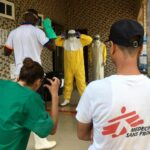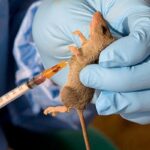
Every day, we constantly interact with microbes in food, water, air and even in our bodies. Microbes are living organisms we can’t see with the naked eye and they may or may not cause disease. Germs are microbes that can cause disease. According to a research conducted by KRC, on average, individuals come into contact with 300 surfaces every 30 minutes, exposing us to 840,000 germs. Hands that touch these surfaces often spread these germs.
Read also MSF warns vigilance must remain on Lassa fever
In health care settings, patients have the right to expect that those who provide their care meet appropriate standards of hygiene and follow the correct procedures to minimize the risk of acquiring infections from the place they have gone for care. The institution of standard infection and control (IPC) practices can prevent infection in hospitals and clinics. This includes a range of measures that reduce the risk of transmission of infection from known and unknown sources. Some Standard IPC measures include: hand hygiene, the use of appropriate personal protective equipment (PPE), safe use and disposal of needles, respiratory hygiene and cough etiquette, aseptic techniques, environmental cleaning, linen management, waste management, etc.
Read also Chasing Lassa fever in Edo state
We have to go back to the basics in Nigeria and ensure that our hospitals and our health care workers are safe for patients. The primary responsibility of health care workers is to first “Do No Harm”! It cannot be overemphasized therefore, that effective infection prevention and control (IPC) is the cornerstone for the delivery of safe, effective, high-quality health care. Practicing hand hygiene is a simple yet effective way of preventing infections. Preventing health care-associated infections avoids unnecessary harm and at times even death, saves money, and reduces the spread of antimicrobial resistant infections. Poor hand hygiene on the other hand leads to the transmission of germs including of those that may be resistant to antibiotics.
So, what can we learn from the history of how hand hygiene has led to a reduction in infections?
In the late 1800s, carrying out autopsies became more common as a means to understand the human body and medical practice. A Hungarian doctor, Ignaz Semmelweis observed that many women in the maternity wards were dying from Puerperal fever (fever apparently caused by uterine infection following childbirth). However, he noticed a difference in death rates between two wards, where one ward had five times more deaths than the other. Semmelweis noticed that healthcare workers in the ward with more deaths from puerperal fever were more likely to have performed autopsies. So, by linking the unclean hands following autopsies to the spread of illness, he introduced hand washing to his medical team before they were allowed to examine women in labour. The number of deaths from Puerperal fever reduced dramatically.
Read also Lassa fever is raging, but just 8 in 10 Nigerians know about it
This occurred 150 years ago and yet hand hygiene still remains a major challenge today. The KRC report also stated that only one out of three persons wash their hands before eating food or after sneezing, coughing or after blowing their nose. About 7% of women and 15% of men do not wash their hands at all after using the bathroom. Even in hospitals, healthcare workers tend to wash their hands more if there is visible body fluid but consider contact with the patients’ surroundings (e.g. beds, IV bottles) less “risky”. The importance of hand hygiene has not been more highlighted than during the 2014 West Africa Ebola outbreak, where 11 of 20 cases were healthcare workers and 90% were infected by direct contact with index case, body fluids or the patient’s environment.
In Nigeria, according to the World Bank, communicable diseases account for 67% of all deaths and major causes of infections include respiratory infections, meningitis and diarrhoeal diseases. Washing one’s hands with soap and water could reduce deaths due to diarrheal diseases (e.g cholera) by half, the risk of respiratory infections by 16% and prevent up to a million deaths annually.
Even when hand washing is performed, one in three persons don’t use soap and only 5% of people wash their hands correctly. Individuals often wash only the palms and do not dry the hands afterwards.
While it is important that we commemorate such a life-saving strategy with a global awareness day, to see meaningful gains from hand hygiene promotion, several components are required to sustain the momentum in the community and health facility.
System change is a component proposed by the World Health Organisation. It is important that the necessary equipment for hand hygiene is put in place in order to improve practice. This means that health-care facilities need to have the necessary basic infrastructure in place to allow health-care workers practice hand hygiene, and hand hygiene should be a quality indicator for infection control. Policy makers need to make infection prevention and hand hygiene a national policy priority by improving water access in Nigerian communities, alongside other measures.
Another important component is education on the need for hand hygiene. For healthcare workers, there are “5 Moments” for performing hand hygiene (Figure 1): before and after touching a patient, before a clean procedure, after exposure to body fluid, after touching a patient and after touching patients’ surroundings.
 |
Proper hand washing as demonstrated in Figure 2 below should last at least 30 seconds, and all surfaces of the hand including nail beds should be washed. Community members need to wash their hands before food preparation, eating food and after visiting the toilet.
 |
Monitoring knowledge, perception and practice of hand hygiene is vital to measuring changes in behaviour and effectiveness of such interventions. UNICEF has supported several countries in conducting hand hygiene surveys, focusing on availability of infrastructure. Lastly, constant reminders are critical since they serve as stimuli for the practice of hand hygiene and this is why WHO set aside today, May 5th, as World Hand Hygiene day. As the Nigeria Centre for Disease Control (NCDC) marks Hand Hygiene Day, we would like to remind healthcare workers that washing your hands doesn’t only protect you and your patients, but it also protects your loved ones and the community from diseases. Want to save someone today? Observe the 5 Moments of Hygiene and teach someone how to do so properly today.
Have a happy Hand Hygiene Day!
Written by the:
Prevention and Programmes Coordination Department,
Nigeria Centre for Disease Control.



